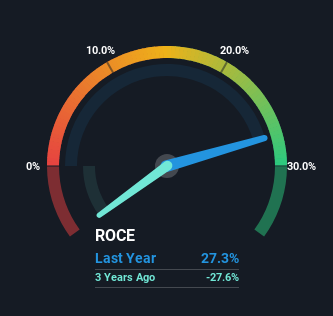- United States
- /
- General Merchandise and Department Stores
- /
- NasdaqGS:PDD
Why The 27% Return On Capital At PDD Holdings (NASDAQ:PDD) Should Have Your Attention

To find a multi-bagger stock, what are the underlying trends we should look for in a business? One common approach is to try and find a company with returns on capital employed (ROCE) that are increasing, in conjunction with a growing amount of capital employed. Ultimately, this demonstrates that it's a business that is reinvesting profits at increasing rates of return. So when we looked at the ROCE trend of PDD Holdings (NASDAQ:PDD) we really liked what we saw.
What Is Return On Capital Employed (ROCE)?
If you haven't worked with ROCE before, it measures the 'return' (pre-tax profit) a company generates from capital employed in its business. The formula for this calculation on PDD Holdings is:
Return on Capital Employed = Earnings Before Interest and Tax (EBIT) ÷ (Total Assets - Current Liabilities)
0.27 = CN¥45b ÷ (CN¥314b - CN¥148b) (Based on the trailing twelve months to September 2023).
Therefore, PDD Holdings has an ROCE of 27%. That's a fantastic return and not only that, it outpaces the average of 12% earned by companies in a similar industry.
See our latest analysis for PDD Holdings

Above you can see how the current ROCE for PDD Holdings compares to its prior returns on capital, but there's only so much you can tell from the past. If you'd like to see what analysts are forecasting going forward, you should check out our free analyst report for PDD Holdings .
What Does the ROCE Trend For PDD Holdings Tell Us?
The fact that PDD Holdings is now generating some pre-tax profits from its prior investments is very encouraging. The company was generating losses five years ago, but now it's earning 27% which is a sight for sore eyes. In addition to that, PDD Holdings is employing 700% more capital than previously which is expected of a company that's trying to break into profitability. This can tell us that the company has plenty of reinvestment opportunities that are able to generate higher returns.
On a separate but related note, it's important to know that PDD Holdings has a current liabilities to total assets ratio of 47%, which we'd consider pretty high. This can bring about some risks because the company is basically operating with a rather large reliance on its suppliers or other sorts of short-term creditors. While it's not necessarily a bad thing, it can be beneficial if this ratio is lower.
What We Can Learn From PDD Holdings' ROCE
In summary, it's great to see that PDD Holdings has managed to break into profitability and is continuing to reinvest in its business. And with the stock having performed exceptionally well over the last five years, these patterns are being accounted for by investors. In light of that, we think it's worth looking further into this stock because if PDD Holdings can keep these trends up, it could have a bright future ahead.
If you want to continue researching PDD Holdings, you might be interested to know about the 1 warning sign that our analysis has discovered.
If you'd like to see other companies earning high returns, check out our free list of companies earning high returns with solid balance sheets here.
New: Manage All Your Stock Portfolios in One Place
We've created the ultimate portfolio companion for stock investors, and it's free.
• Connect an unlimited number of Portfolios and see your total in one currency
• Be alerted to new Warning Signs or Risks via email or mobile
• Track the Fair Value of your stocks
Have feedback on this article? Concerned about the content? Get in touch with us directly. Alternatively, email editorial-team (at) simplywallst.com.
This article by Simply Wall St is general in nature. We provide commentary based on historical data and analyst forecasts only using an unbiased methodology and our articles are not intended to be financial advice. It does not constitute a recommendation to buy or sell any stock, and does not take account of your objectives, or your financial situation. We aim to bring you long-term focused analysis driven by fundamental data. Note that our analysis may not factor in the latest price-sensitive company announcements or qualitative material. Simply Wall St has no position in any stocks mentioned.
About NasdaqGS:PDD
PDD Holdings
A multinational commerce group that owns and operates a portfolio of businesses.
Flawless balance sheet and undervalued.
Similar Companies
Market Insights
Community Narratives





